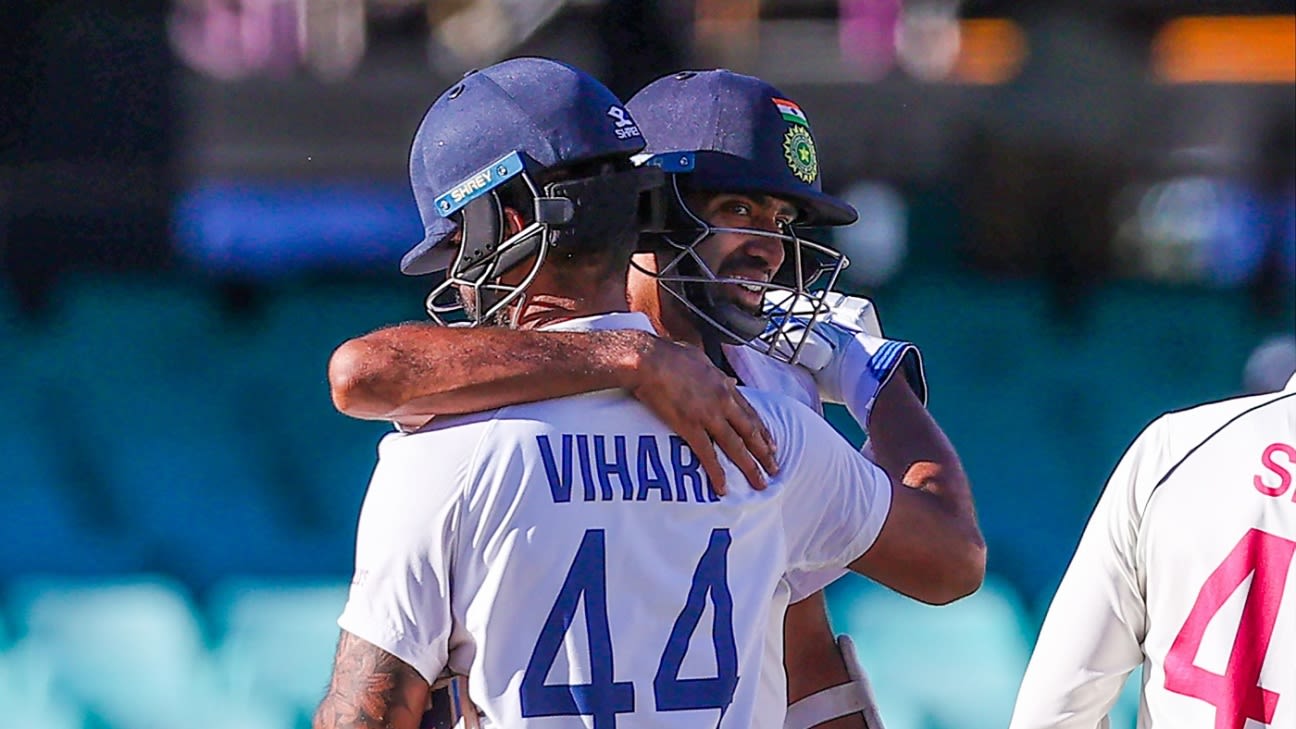
It was clear communication between the two that both R Ashwin and Hanuma Vihari singled out as the backbone of their record stonewalling effort that denied Australia the Test victory in Sydney and the series lead.
Although their alliance was only 62 runs, Ashwin and Vihari battled for 256 deliveries, the fourth-longest partnership recorded for the sixth wicket in the fourth innings of a Test in a win or a draw. Both players faced equal number of deliveries, 128, and the vigil earned Ashwin the honour of being ranked fifth on the list of most balls faced by an India No. 7 in the fourth innings.
The most remarkable aspect of the partnership was that Ashwin was battling a bad back while Vihari had to bat with a strapped right hamstring, which he suffered early in his innings while completing a single. Yet both men swallowed the pain and relentless questioning from the world's best Test bowling attack to return wounded, but undefeated.
Little wonder then Ashwin said the pair was "numb and blank" recounting one of the best days witnessed in modern Test cricket despite the result being a draw. "It was really, really special," Ashwin told bcci.tv after the match on Monday. "In fact, both of us went numb and blank for a while; we didn't even celebrate towards the end because we didn't know what to make of it."
Sitting outside the visitors' dressing room, in the old-world Members' Stand at the Sydney Cricket Ground, with the late evening sun glowing on their faces, both men were exhausted, but refreshed by the result. So what was the plan? How would they survive?
"The communication was very, very good," Ashwin said. "I am not sure if runs were very awfully important in that partnership. It was more about batting time. Whenever we are comfortable with a certain bowler in a certain spell then we wanted to hang on that side especially with his hamstring injury and my back. Also we didn't really want to keep chopping and changing and losing our concentration or playing a shot or two. We really hung in tight. Because we were so channelised in taking on a certain particular bowler and keep blocking, keep dead batting him."
Ashwin had already praised Vihari in his chats with the various broadcasters and once again called the performance "outstanding". Vihari made just 20 runs, but blunted the Australian fast bowling attack calmly and confidently. "Vihari's effort was outstanding because of how he was able to grind and dig deep."
Vihari, playing only his 12th Test, was nervous as he was also batting for his position after poor returns in the first five innings of the series. At the end he was proud. "It was something you can only dream of, batting on day five of a Test match," Vihari said. "The series is one-all and if you can do it for the team that satisfaction will slowly sink in and realise how big an effort that was.
"Ash [Ashwin] (was) like an elder brother, he was communicating. Whenever he felt I was a bit loose, he was telling me that 'let us focus one ball at a time and take as deep as possible.'"
Overall India batted for 131 overs in the fourth innings for the draw. It was only the sixth instance of a team batting for more than 130 overs (of six balls) to save a Test in Australia and only the second since 1971. The last time it happened was in 2012 when South Africa battled to a draw in the second Test to keep the three-match series at 0-0.
That match became historic due to the gallantry and patience of Faf du Plessis, who batted nearly eight hours and an entire fifth day for his 110 not out which took 376 deliveries and denied Australia a victory despite South Africa being asked to follow-on.
And it was du Plessis, Ashwin said, who was on his mind when he went to sleep on Sunday night, with India 309 runs adrift of the target. "If you talk about premonitions, from last night when I went to bed with a sore back, I was just telling myself that: if I can just keep dead batting everything like how Faf du Plessis did at Adelaide, I can give myself a good chance."
Ashwin's confidence never wavered despite him consistent pressure from the Australian pace attack and the constant probing around his off stump by Nathan Lyon. He might have been uncomfortable against the fast bowlers, and even had to resort to a chest guard after being folded in two by Pat Cummins, but against Lyon, Ashwin was in total command, meeting the ball in front of his pads. Yet, as Ashwin explained, the back pain was unrelenting.
"When I went in to bat, Nathan Lyon was bowling. And for the first 3-4 balls that I stretched my back (pain) was shooting through from my lower back to my neck. So I went I told him (Vihari) I should not have played that shot over the top because it completely tweaked it out. And then if I gave it a break for an over, my back was getting stiff again. So I told him I will stay here and keep playing because if I don't play it stiffens up and I have to get the chest guard on.
"In the middle of a Pat Cummins spell we found ourselves in the eye of the storm. There was a bit of luck for us but we got through pretty well."
Vihari is understood to miss the final Test and probably even the home series against England in February, but he was happy that he had played a significant part in a memorable Test. He felt that if he was fit India could have even won the Test. "Getting a draw was a fabulous result. If I was fit, if I was not injured, and Puji [Cheteshwar Pujara] was there for some more time we would have had a different result, may be. It would have been a fabulous win. Nonetheless 10 points of this game is a massive result for us."
Nagraj Gollapudi is news editor at ESPNcricinfo















 Phone: (800) 737. 6040
Phone: (800) 737. 6040 Fax: (800) 825 5558
Fax: (800) 825 5558 Website:
Website:  Email:
Email: 






